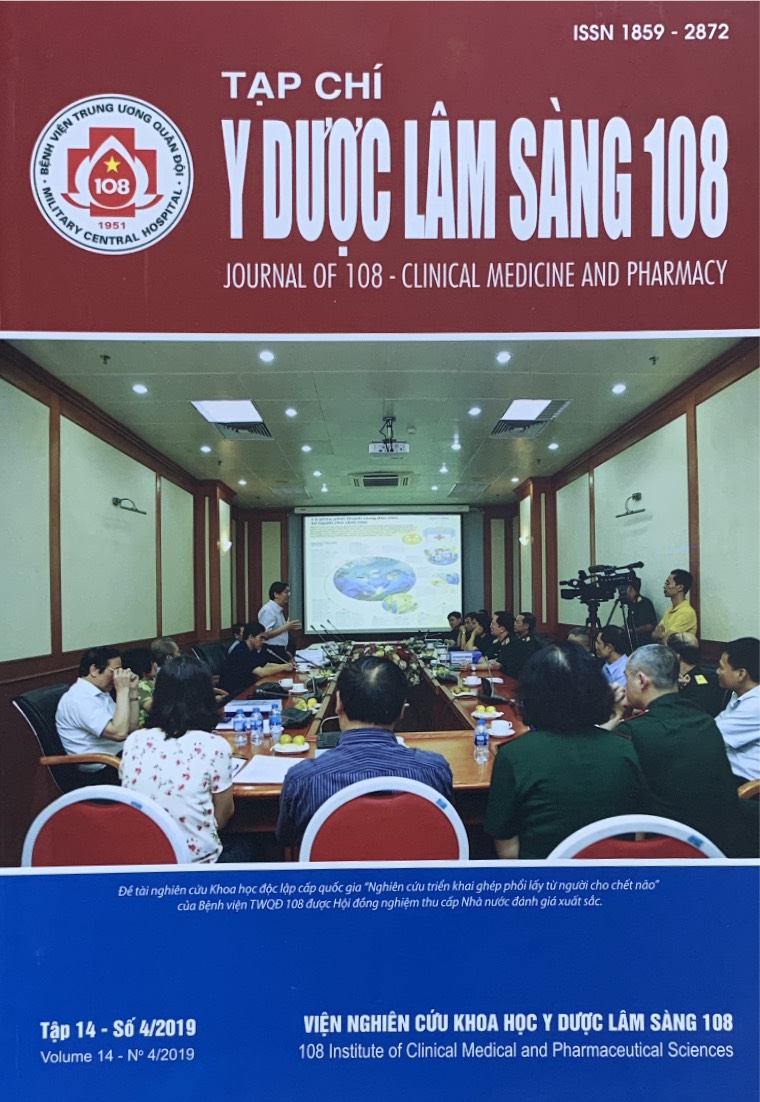To determine the correlation between cardiac mechanical synchrony parameters using tissue synchronization imaging (TSI) and GSPECT in patient after myocardial infarction
Main Article Content
Keywords
Abstract
Objective: To determine the correlation between cardiac mechanical synchrony parameters using tissue synchronization imaging (TSI) and GSPECT in patient after myocardial infarction. Subject and method: Cross-sectional study was conducted on 34 subjects without cardiovascular disease and 104 patients after myocardial infarction. Result: The average age of disease group was 65.4 ± 10.3 years with 83.96% male and control group was 62.7 ± 6.4 years with 76.47%. Values of cardiac mechanical synchrony parameters include of disease group was: Ts-Diff 12: 121.81 ± 49.81, Ts-SD 12: 43.16 ± 22.19, PSD: 48.69 ± 19.49 and HBW: 154.95 ± 71.97. Both of Ts-Diff 12 and Ts-SD 12 were linearly correlated with PSD and HBW (r was 0.64, 0.57 and 0.60; 0.53 respectively). Conclusion: The values of cardiac mechanical synchrony parameters using TSI in patient after myocardial infarction is correlated with parameters using GSPECT.
Article Details
References
2. Ng A.C.T, Tran D.T., Allman C et al (2010) Prognostic implications of left ventricular dyssynchrony early after non-ST elevation myocardial infarction without congestive heart failure. Eur Heart J 31(3): 298-308.
3. Ko JS, Jeong MH, Lee MG et al (2009) Left ventricular dyssynchrony after acute myocardial infarction is a powerful indicator of left ventricular remodeling. Korean Circ J 39(6): 236-242.
4. Pazhenkottil, Aju P, Buechel, Ronny R, and Husmann, Lars (2011) Long-term prognostic value of left ventricular dyssynchrony assessment by phase analysis from myocardial perfusion imaging. Heart 97: 33-37.
5. Gorcsan J, Abraham T, Agler DA et al (2008) Echocardiography for cardiac resynchronization therapy: Recommendations for performance and reporting - a report from the American Society of echocardiography dyssynchrony writing group endorsed by the heart rhythm society. J Am Soc Echocardiogr 21(3): 191-213.
6. Holly, Thomas A, Abbott, Brian G and Al-Mallah, Mouaz (2010) Asnc imaging guidelines for nuclear cardiology procedures: Single photon-emission computed tomography. Journal of Nuclear Cardiology 17(5): 941-973.
7. Chen, Ji, Garcia, Ernest V and Bax, Jeroen J (2011) SPECT myocardial perfusion imaging for the assessment of left ventricular mechanical dyssynchrony. Journal of Nuclear Cardiology 18(4): 685-694.
8. Chen, Ji, Garcia, Ernest V, and Folks, Russell D (2005) Onset of left ventricular mechanical contraction as determined by phase analysis of ECG-gated myocardial perfusion SPECT imaging: Development of a diagnostic tool for assessment of cardiac mechanical dyssynchrony. Journal of Nuclear Cardiology 12(6): 687-695.
9. Alam I, Haque T, Badiuzzaman M et al (2016) Left ventricular dyssynchrony in acute ST elevated myocardial infarction in patients with normal QRS duration. Bangladesh Heart Journal 30(1): 13-21.
10. Henneman MM, Chen J, Dibbets-Schneider P et al (2007) Can LV dyssynchrony as assessed with phase analysis on gated myocardial perfusion SPECT predict response to CRT?. J Nucl Med 48(7): 1104-1111.
 ISSN: 1859 - 2872
ISSN: 1859 - 2872
